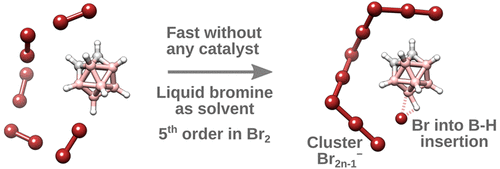В журнале Inorganic Chemistry (IF 4,825) опубликована статья с участием сотрудников Института снс(к.х.н.) А.В.Шернюкова, снс Г.Е. Сальникова, мнс Д.А. Рудакова и снс(к.х.н.) А.М. Генаева
The Key Role of Anionic Bromine Clusters Facilitating Br Atom Insertion into the B-H σ-Bond
Andrey V. Shernyukov, George E. Salnikov, Dmitry A. Rudakov, and Alexander M. Genaev*
Inorg. Chem. 2021, 60, 5, 3106–3116
Publication Date:February 17, 2021
https://doi.org/10.1021/acs.inorgchem.0c03392

Abstract
The mechanism of the noncatalytic bromination of carboranes was studied experimentally and theoretically. We found that the reactions of o- and m-carboranes 1 and 2 with elemental bromine are first order in the substrate but unusually high (approximately fifth) order in bromine. The calculated energy barriers of these reactions decrease sharply as more bromine molecules are added to the quantum-chemical system. A considerable primary deuterium kinetic isotope effect for the bromination of 2 indicates that the rate-limiting stage is B–H bond breakage. According to quantum-chemical reaction path calculations, the bond breakage proceeds after the intrusion of a bromine atom into the B–H σ-bond. The 9-Br and 9-OH substituents in carborane 1 strongly retard the bromination of the corresponding derivatives. The bromination mechanism of 9-OH-1 is complex and includes neutral, deprotonated, and protonated forms of the carborane. The high experimental kinetic reaction order in bromine, together with quantum chemical modeling, points to a specific mechanism of bromination facilitated by anionic bromine clusters which significantly stabilize the transition state.
Альметрики:


